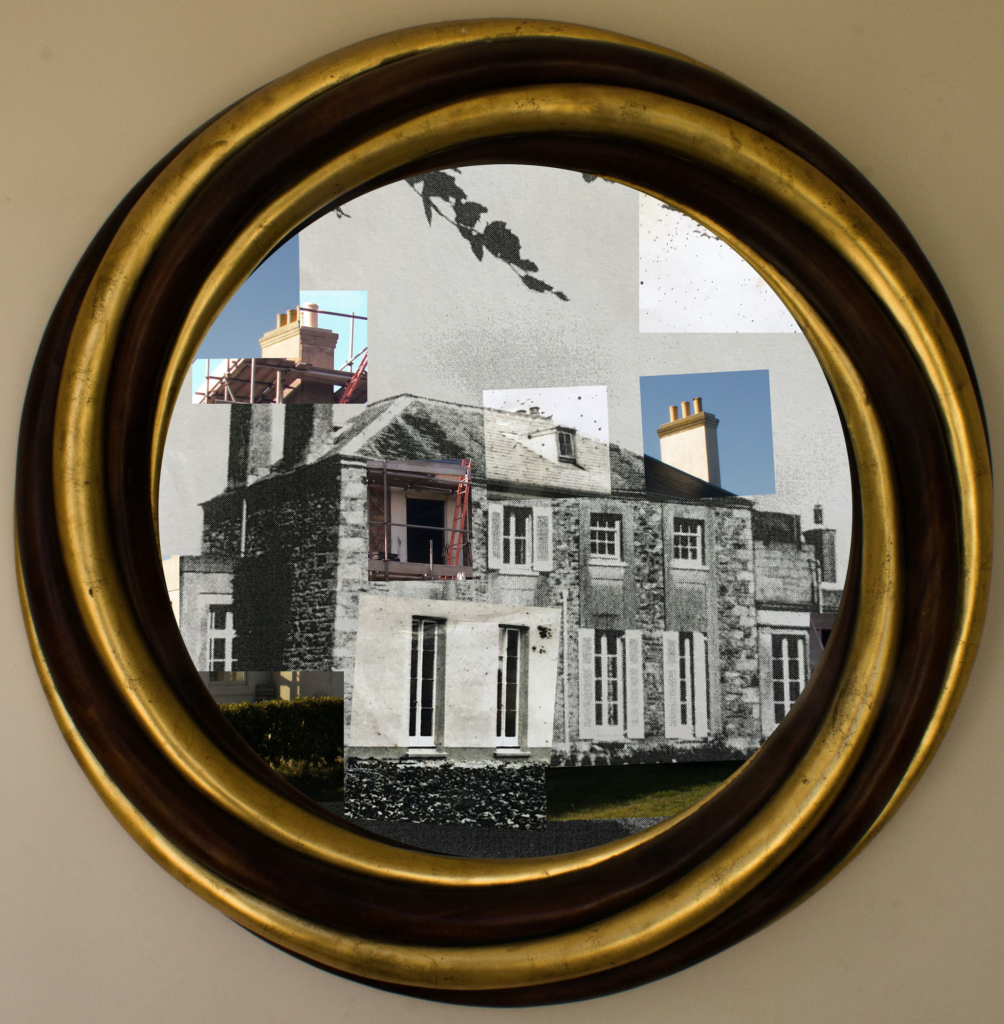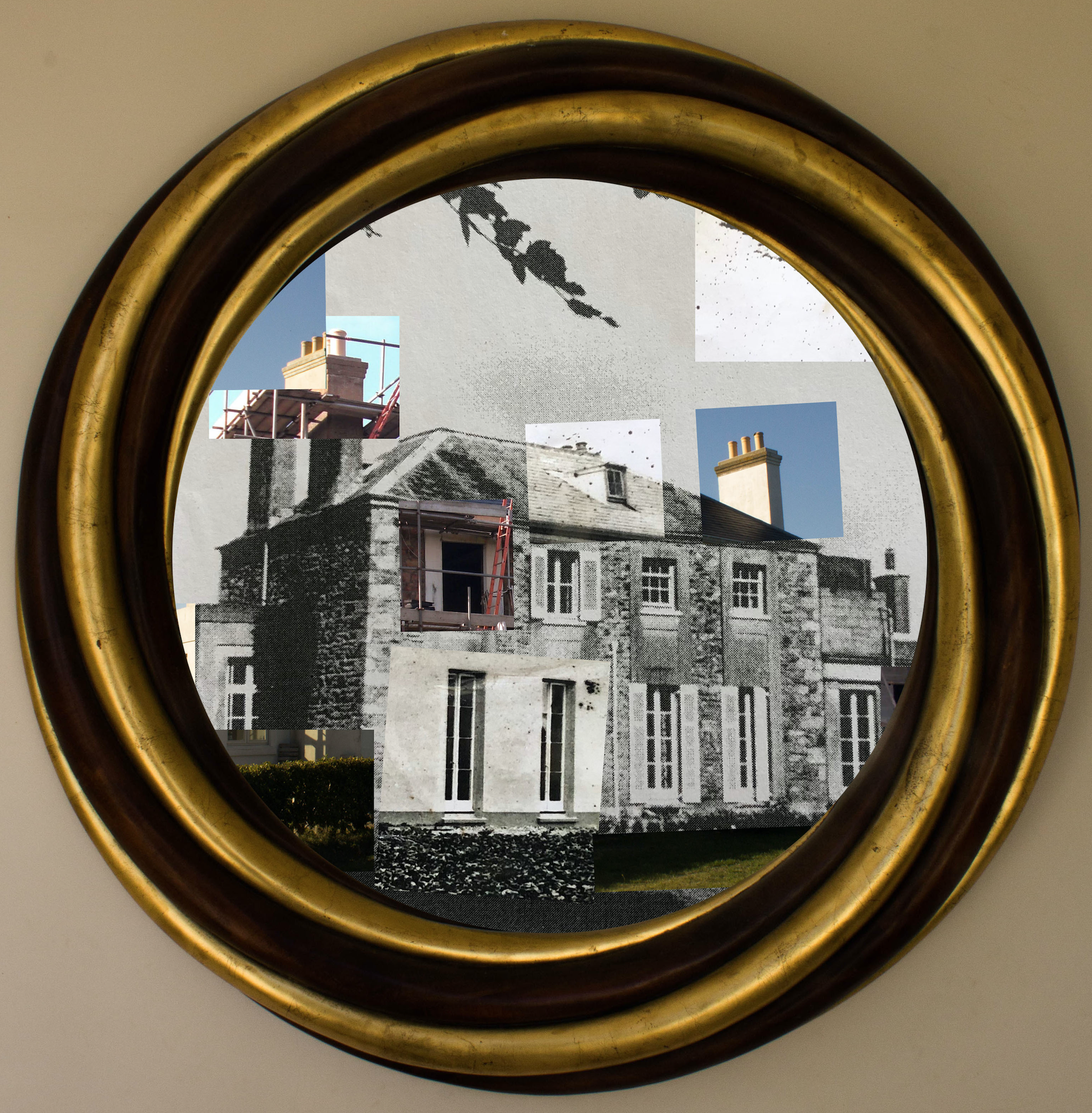I have chosen to use the technique of pasting and cropping photographs over a base photographs and placing them in different places in order to align with the base photographs in order to create an interesting and contrasting composition. This allows me to be creative with the selection and placement of the photographs in order to emphasise as much as possible the differences and similarities between the past and present uses of the land. I will also be incorporating technique 3 into this by using natural frames such as mirrors and windows around the house in order to provide a more personal and interesting touch by showing how the fashion and style of property design has changed through time.
In order to provide myself with more photographs/frames to work with I have conducted an additional mini photoshoot within my household in which I photographed more frames and decorations within the house. I can use these photographs to broaden the variety of edits in my final outcome and to further show the current fashion and style within households.


In the edits I have used photoshop to alter/crop the montage photographs or archival photographs to fit within the natural framings that I photographed around my household and then placed the montages within the frame. I have done this to create a sense of personalisation within the edits as well as delving deeper into the theme of political landscape by showing how the inner decoration of the land changes over time, as well as the buildings themselves. The mixture of new and old photographs along with the modern decorations allows for the changes and developments over time to be shown as clearly as possible.
The majority of the photographs show the different sections of the houses and their developments through the use of montages but I have devoted one of the photograph edits to only the archival images within the frame in order for these photographs to be appreciated as they are without the contrast with the new photographs distracting the viewer from it. I have also included an edit which shows an archival photograph of me and my dad on the property in order to show that political landscape includes how the people involved in the change of land develop.





Analysis

In this photograph natural lighting was used in all aspects from the photograph of the frame to the photograph of the house from 1873. This use of natural lighting has allowed for the natural shadows of the structure to be shown which helps to create contrast between the different shapes and angles in the structure of the house. There is a very wide tonal range in this photograph due to its montage nature – the bright white paint of the newly refurbished house contrasts against the black hole that is the window being renovated, this helps to create multiple viewpoints and areas of interest of which all contrast with eachother. A deep depth of field is used for all of the photographs involved in this montage as the whole of the photograph is in focus which allows for all the small details of the contrasts between the old and new to be seen. A shutter speed of 1/50 was used to capture the mirror frame along with an ISO of 200 as I wanted the frame to be of as high a quality as possible in order for it to compliment the photographs within it. For the photographs within the frame a slightly quicker shutter speed along with a lower ISO will have been used as the photograph was taken outside so the shutter did not need as much time to allow the light to enter the lens. The photographs are all correctly exposed but the exposures between the different photographs in the montage contrast with eachother to show the differences between them.
The colours in this photograph vary greatly due to the nature of the montage – the frame shows a dark gold and brown to contrast with the predominantly black and white montage. In the predominantly black and white montage there are splashes of colour through the inclusion of the photographs showing the current state of the house. These splashes of colour create a more interesting viewing and reminds the viewer how much technology has changed overtime to go from black and white to colour photography as well as the landscapes. There is a slight 3D effect to the montage as the closer corner of the house enters the background with the far corner being pushed towards the background – this 3D effect is further added to by the frame surrounding the montage, which creates a much more interesting and intriguing photograph. The frame is positioned directly around the centre of the photograph to allow the viewer clear viewing into what the frame is showing. This centralisation of the frame looks very orderly and neat which contrasts with the chaotic structure of the montage that it contains. The montage is placed within the frame in a way that shows as much of it as possible in order to convey my ideas within political landscape further. There are lots of viewpoints within the photograph as there is so much going on – which is possibly a bad thing – but I feel that there is a lot being said through this photograph so that fits the busyness of it.
This photograph is made from a collection of archival photographs and new photographs of my house. This collection of photographs represent the history of the house and the changes that it has gone through. I have incorporated both archival and new photographs to demonstrate how the genre of political landscape links to these photographs. The house has many similarities to cod houses through the shape and style – these cod houses were built in the 18th and 19th century from people who made their wealth through the North Atlantic cod trade which can be seen as one of the initial sources of wealth within Jersey. After research on the house I could not find any evidence that this is a cod house but the similarities and shapes are very close. This photograph has strong links to political landscapes and Guillame Bression and Carlos Ayesta’s work due to exploring what humans can do to a landscape and how drastically landscapes can change over a time period.
The idea behind this photograph is to show how even though fashion and trends come and go, they always come back around. This photograph shows sections of the house through photographs that are taken nearly 150 years apart – even though they are taken so many years apart the structure and shape of the building has remained. In the 1870 period only the people who could afford to would plaster their houses, but then later on it came into fashion for houses to have granite showing (as seen in the photograph) so the house was stripped of its plaster to reveal the granite structure. In the current state the house has been re-plastered in order to meet fashion trends and in order to show some inspiration from the original style of the property. This loop of fashion and trend shows how political landscapes often take inspiration from the past whilst putting a modern spin on them.
